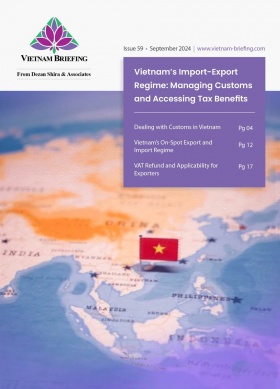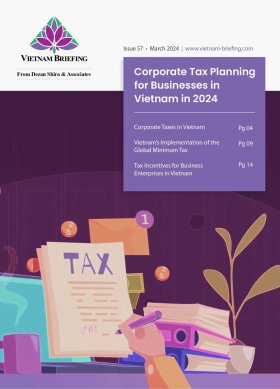An Introduction to Vietnam’s Leading Import and Export Industries
Vietnam’s rise as a global manufacturing hub, driven by the China+1 strategy, positions it as a key destination for business relocation. With positive growth forecasts for the import-export sector, the country is set to thrive as the global economy recovers. Industries primed for robust import and export activities, as highlighted by Vietnam Briefing, include electronics, textiles, pharmaceuticals, coffee, and e-commerce, making Vietnam a strategic player in global trade.
Vietnam’s rising manufacturing profile in the Asia-Pacific
With its rising costs, China is no longer the go-to destination for many businesses, and Vietnam has arisen as a serious competitor. Recent trends show that the number of orders shifting from China to Vietnam has seen a significant increase.
For example, China’s Pearl River Delta, long known as one of the key factory centers for the world’s manufacturers (particularly those from Hong Kong) has now become too costly for many companies to stay in the region.
In the past few years, a growing number of businesses have relocated their operations from China to Vietnam in an attempt to escape rising costs and an increasingly complex regulatory environment.
Located in a strategic position for foreign companies with operations throughout Southeast Asia, Vietnam also serves as an ideal export hub to reach other ASEAN markets.
Compared with other developing markets in the region, Vietnam is a clear leader in low-cost manufacturing and sourcing. Its processing and manufacturing industry accounted for nearly 20 percent of the GDP in 2023, with the government’s goal of raising it to 25 percent of the GDP by 2025.
Network of trade agreements
Another driving force behind Vietnam’s growing popularity is the country’s network of free trade agreements (FTAs).
Given the ongoing trade war between China and the US, alongside Vietnam’s recent FTAs, such as the RCEP, the EVFTA, and the UKVFTA, the country is steadily becoming more open to international trade and investment.
In 2020, manufacturing labor costs in Vietnam were approximately 50 percent of those in China at US$2.99 per hour compared to US$6.50 per hour respectively, and around 40 percent of those reported in Thailand and the Philippines.
As of 2024, HR platform Velocity Global ranked Vietnam among the top 10 countries with the lowest minimum wages. Vietnam’s regional minimum wage ranges from US$140 (VND 3,445,000) to US$202 (VND 4,960,800) per month, while that of the Philippines and Indonesia are in the ranges of US$128-229 and US$130-325, respectively.
With the country’s workforce growing annually, Vietnamese workers are comparatively inexpensive, young, and, increasingly, highly skilled.
Role of the RCEP
The RCEP, which came into force on January 1, 2022, has also fostered the entry of goods exported in and out of Vietnam as it reduces cost, improves market access, and offers streamlined customs procedures. Research published by Vietnam’s National Economics University (NEU) in April 2023 showed that the RCEP positively boosted FDI inflows into Vietnam, resulting from its commitments to open markets, the harmonization of rules of origin among all participating parties, as well as enhancing trade facilitation measures.
Business environment
In terms of regulatory and financial incentives, Vietnam has become increasingly investor-friendly in recent years – the government has taken actions to reform its financial sector, streamlining business regulations, and improving the quality of its workforce.
Since the mid-2000s, the Vietnamese government has offered extremely competitive financial incentives to businesses seeking to set up operations in the country, in addition to a zero percent withholding tax on dividends remitted overseas and a low corporate income tax (CIT) rate of 20 percent. These advantages have enabled Vietnam to become a premier “sourcing economy” in the eyes of many companies.
Current state of Vietnam’s economy
Vietnam is seeing strong growth on multiple fronts. Of particular interest to investors has been the continuing growth of Vietnam’s domestic consumer market, which has been developing by leaps and bounds.
This growth is expected to continue for some time to come – domestic consumption is predicted to increase at a rate of 20 percent per year. On June 10, the General Statistics Office (GSO) released the latest data showing total retail sales and consumer service revenue in the first three quarters of 2024 reached a record VND4.7 trillion (around US$190 million), up 8.8 percent year-on-year, reflecting a symbolic recovery of the economy.
With a population of over 100 million by the end of 2023 and Southeast Asia’s fastest-growing middle class, Vietnam clearly represents an important market for foreign goods. The US maintained its status as the largest export market for Vietnam in 2023, followed by China, South Korea, and Japan.
|
Vietnam’s Top Export Markets (2023) |
|
|
Export market |
Export value |
|
USA |
US$96.99 billion |
|
China |
US$60.71 billion |
|
South Korea |
US$23.45 billion |
|
Japan |
US$23.29 billion |
|
Hong Kong |
US$10.23 billion |
|
Vietnam’s Top Import Markets (2023) |
|
|
Source of import |
Import value |
|
China |
US$110.63 billion |
|
South Korea |
US$52.47 billion |
|
Japan |
US$21.63 billion |
|
Taiwan |
US$18.42 billion |
|
USA |
US$13.82 billion |
Key export trade industries in Vietnam
While Vietnam is widely known for being a prime location for investors operating in the textile industry, there are many other business areas that are seeing significant growth in the country. Interestingly, Vietnam is well on its way to becoming a key location for high-technology manufacturing, with companies like Samsung, LG Electronics, Nokia, and Intel making multi-billion-dollar investments into the country. Other business areas include information and communications technology, automotive, and medical devices.
In 2023, the total import-export turnover between Vietnam and the US reached nearly US$111 billion, marking the third consecutive year that Vietnam-US trade turnover recorded more than US$100 billion.
|
Vietnam’s Top Export Goods (2023) |
|
|
Export item |
Export value |
|
Electronic goods / computers |
US$57.34 billion |
|
Phones and components |
US$52.38 billion |
|
Machinery |
US$43.13 billion |
|
Textiles |
US$33.33 billion |
|
Footwear |
US$20.24 billion |
|
Vietnam’s Top Import Goods (2023) |
|
|
Import item |
Import value |
|
Electronic goods / computers |
US$88 billion |
|
Machinery |
US$41.6 billion |
|
Fabrics |
US$13 billion |
|
Iron and steel |
US$10.4 billion |
|
Plastics (in primary form) |
US$9.8 billion |
Textiles and garments
Textiles consistently rank among Vietnam’s leading export industries, with over 6000 textiles and garments manufacturing companies, employing upwards of 2.5 million workers. The growth of the garment industry has been impressive and plays an important role in the economic growth of the country.
In the first five months of 2024, Vietnam became the leading country for textile and garment exports to the United States, surpassing China, with exports reaching approximately US$16 billion, a 5 percent increase from the previous year. This includes US$6 billion in exports to the US alone, representing a 4 percent rise, which highlights Vietnam’s strong growth compared to other top exporters like Bangladesh and China.
The Vietnamese textile and garment industry has shown signs of improvement thanks to most major markets, such as the US and Europe, successfully controlling inflation and resuscitating purchasing power. In addition, Vietnamese textile and garment enterprises have also proactively diversified their markets and customers in recent times. Experts forecast that the industry’s export turnover in 2024 will increase by 8-10 percent compared to 2023. Within ASEAN, Vietnam is the strongest competitor for inheriting low value-added textiles and apparel manufacturing from China. In contrast to other leading textile exporters in the region (Indonesia, Thailand, Malaysia), the share of Vietnam’s textile exports against its total exports has grown in recent years.
Electronics
Vietnam has emerged as an important electronics exporter, with electrical and electronic products overtaking coffee, textiles, and rice to become the country’s top export item. Samsung is Vietnam’s largest exporter and has helped the country achieve a trade surplus for the first time in many years.
Exports of smartphones and computer parts now account for more in export earnings than oil and garments. Samsung has turned Vietnam into a global manufacturing base for its products, producing almost a third of the firm’s output. Samsung’s four main factories in Vietnam contributed around 30 percent of its global revenues in the first half of 2024, with the combined revenues rising by 8.6 percent year-on-year to US$31.39 billion.
Samsung has also agreed to cooperate with the Vietnamese government in order to help develop the country’s domestic support industries. This represents a key business opportunity for foreign technology companies to set up operations in Vietnam and sell their components to companies like Samsung.
Pharmaceuticals
The future looks to be very interesting for the pharmaceutical industry in Vietnam. Vietnam’s pharmaceutical market is projected to increase to US$7.7 billion in 2021 and US$16.1 billion in 2026. According to the Drug Administration of Vietnam under the Ministry of Health, as of August 2024, the Vietnamese pharmaceutical market was approximately US$7 billion, with an average drug consumption of US$70 per capita, marking a 10-fold increase compared to 2000. Driving this market growth is the Vietnamese government’s goal of achieving universal health coverage, combined with a growing market of consumers who want accessible healthcare.
As per IQVIA (2021), as of 2020, Vietnam has around 250 manufacturing factories, 200 import-export units, 4,300 wholesalers, and another 62,000 retailers catering to the pharmaceutical industry.
Automotive
Vietnam is becoming an important market for auto sales: the Vietnamese automobile market is expected to sell 1.7-1.85 million units by 2035. According to the Vietnam Automobile Manufacturers’ Association (VAMA), auto sales in July this year increased 9 percent from the previous month to 28,920 units. During the seven-month span from January to July 2024, VAMA members sold 163,804 automobiles, a 1 percent year-on-year rise. In the foreseeable future, an estimated 750,000-800,000 units are expected to be sold by 2025.
Although the nation’s rate of car ownership per capita is still much lower than other markets in Asia (only around 5.7 percent of Vietnamese households owned a car in 2020), Vietnam is still one of the countries with the fastest-growing purchasing power for personal cars over the past 10 years. Nine percent of Vietnamese households are expected to own a car by 2025 – equivalent to the current level of India and the Philippines. By 2030, car ownership will reach 30 percent. Tax reductions on imported cars and increased income are attributed to the growth.
Despite an increasingly competitive auto market throughout the ASEAN region, Vietnam has stated that it intends to work aggressively to build up its own domestic automotive industry. Among the key reasons for this goal is that the auto industry has the potential to create thousands of jobs for locals and create a strong system of supporting industries.
Electric vehicles
Electric vehicles (EVs) have emerged as a significant trend in Vietnam in recent years. With an estimated 6.5 million cars and 74 million motorbikes on the roads in 2024, the country ranks second in Southeast Asia for greenhouse gas emissions from road transport, behind only Indonesia. This presents a lucrative opportunity for EV growth, especially given the Vietnamese government’s commitment to achieving net-zero emissions by 2050. VAMA projects that EV sales in Vietnam could reach 1 million units by 2028 and 3.5 million by 2040.
The electric motorbike market is particularly strong, with annual sales of 200,000 to 300,000 units. Growth has surged from 6.3-9.6 percent annually between 2020 and 2022 to an impressive 20-30 percent more recently. As of 2024, approximately 3 million electric motorbikes are in circulation nationwide.
VinFast, Vietnam’s leading EV manufacturer, operates a plant in Hai Phong City with an annual capacity of 250,000 units, set to expand to 500,000 units in the next phase. Other domestic players such as Dat Bike and Son Ha (with their Evgo and Ecooter brands) are also strong competitors, alongside China-backed Vietnam Yadea, which has sold over 100,000 electric motorbikes since entering the market five years ago. These companies are actively upgrading their production capabilities to increase exports.
In the electric car segment, VinFast made history as the first Vietnamese automaker to export EVs to the US, shipping 999 units in 2022. In April 2023, they followed up with a second batch of 1,879 vehicles to the US and Canada.
These developments signal a promising future for Vietnam’s EV exports as automakers set ambitious goals to expand their presence in foreign markets.
Coffee
Vietnam is currently, the world’s second-largest coffee exporter, behind only Brazil. In the first six months of 2024, Vietnam’s coffee export value reached more than US$3 billion. Playing an important role in Vietnam’s agriculture economy, coffee is a major export-oriented industry with more than 90 percent of production volume exported. To increase its value, the government has been promoting the shift from exporting beans to processed coffee.
Many experts believe that Vietnam has the potential to overtake Brazil due to its favorable climate conditions and lower-cost production.
E-commerce
Vietnam is quickly becoming a prime market for foreign investment in e-commerce activities. The country’s rapidly growing economy and middle class are, in turn, spawning a strong consumer culture and increasing levels of disposable income. The COVID-19 pandemic accelerated the demand for electronic retail as delivery, ride-sharing, and e-wallets gradually become a norm for the Vietnamese, especially among the youth.
According to a report by Momentum Works published last July, Vietnam was the fastest-growing e-commerce market in Southeast Asia in 2023, with gross merchandise value (GMV) increases of 52.9 percent year over year. The country overtook the Philippines as the third-largest e-commerce market in the region.
Being a signatory to 13 FTAs, Vietnam also provides favorable conditions for investors to start a business in e-commerce with reduced or zero customs tariffs on commodities imported or exported from other countries.
FAQ about Vietnam's Imports and Exports
What are Vietnam’s main industries?
Vietnam’s main industries are electronics, machinery, steel, food processing, wood, textile, and footwear. The service industry became Vietnam’s largest economic sector, accounting for 42.54 percent of GDP and nearly 40 percent of the total employed workers in 2023, according to the General Statistics Office.
What are the major imports of Vietnam?
In 2023, Vietnam’s major imports included computers, electrical products, and components, which accounted for nearly 27 percent of total imports. Fuel products, such as coal, crude oil, gasoline, and liquefied petroleum gas, followed, comprising approximately 23 percent of imports.
What are Vietnam’s major exports?
In 2023, seven export items valued at over US$10 billion accounted for 66 percent of the country’s total export turnover. These were computers, electronic products, and components; phones and components; machinery, equipment, tools, and spare parts; textiles; footwear; means of transport, spare parts; and wood and wood products.
Does Vietnam rely on imports?
Vietnam’s manufacturing and processing sector heavily depends on imported raw materials, intermediate products, and production machinery. The country’s localization rate is only 41.9 percent, including 17.2 percent contribution from local firms, significantly lower than its neighbors.
Who is Vietnam’s biggest trade partner?
In 2023, China was Vietnam’s biggest trade partner, and the two-way trade turnover reached US$171.9 billion.
This article was originally published in March 2022. It was last updated October 8, 2024.
About Us
Vietnam Briefing is one of five regional publications under the Asia Briefing brand. It is supported by Dezan Shira & Associates, a pan-Asia, multi-disciplinary professional services firm that assists foreign investors throughout Asia, including through offices in Hanoi, Ho Chi Minh City, and Da Nang in Vietnam. Dezan Shira & Associates also maintains offices or has alliance partners assisting foreign investors in China, Hong Kong SAR, Indonesia, Singapore, Malaysia, Mongolia, Dubai (UAE), Japan, South Korea, Nepal, The Philippines, Sri Lanka, Thailand, Italy, Germany, Bangladesh, Australia, United States, and United Kingdom and Ireland.
For a complimentary subscription to Vietnam Briefing’s content products, please click here. For support with establishing a business in Vietnam or for assistance in analyzing and entering markets, please contact the firm at vietnam@dezshira.com or visit us at www.dezshira.com
- Previous Article Presentazione delle principali industrie di import-export del Vietnam
- Next Article Vietnam als Manufacturingstandort: Industrieparks in Nordvietnam









Hello,
Pls mail me your newsletters
Regards
Nithin
[…] RELATED: An Introduction to Vietnam’s Import & Export Industries […]
Dear Nithin,
Feel free to sign up to our newsletter here at: http://www.vietnam-briefing.com/about-us/subscription.html
Kind regards,
Charles
best of the best
I have business interest with Vietnam, how do I get started please? Mostly on textile s and communication s
Thanks Oliver. Please reach out to our experts at vietnam@dezshira.com or http://www.dezshira.com who can better understand your query.
Great Day!
This is Jacob, field operation’s Manager and Sales Director of JRA & PEARL Enterprises!
I hope you are all safe and doing fine despite the global pandemic issue we’re currently facing. We’ve been a resilient and professionally transparent importer and exporter in Customs Administration in Philippines’ Trade and Forwarding industry with much established company grounds and affordably quoted products and commodities. Globally competitive offers, on timely faster transactions, and genuine service providers in every import and export Matters.
We’d like to seek for a mutually beneficial business partnership with your successive and respective company and team’s campaign. We are a brokerage; with different partners in import and export industry. Globally dealing with the customs administrations and different country’s ports and airline industry mainly for trading and forwarding different products and commodities coming from different countries around the globe.
We’d love to hear more from your company’s business success and we are looking forward for a better business dealings and partnerships with you!
Safest Regards,
JACOB J. TUBALLA
JRA & PEARL ENTERPRISES
404 A Femii Bldg. A. Soriano Jr. Ave. Intramuros Manila 1002
TEL. # 8371 1332 / 09064468845 / 09260394409
can you please send me ANY link where i can find exporters from vietnam
Hi Rahul,
Please contact our experts at vietnam@dezshira.com or http://www.dezshira.com who can help answer your query.
Hi, I am from India.
I need the list of importers n exporter from Vietnam. Want to explore areas where we can do good business together.
Will you suggest me how could I found importers of Vietnam.